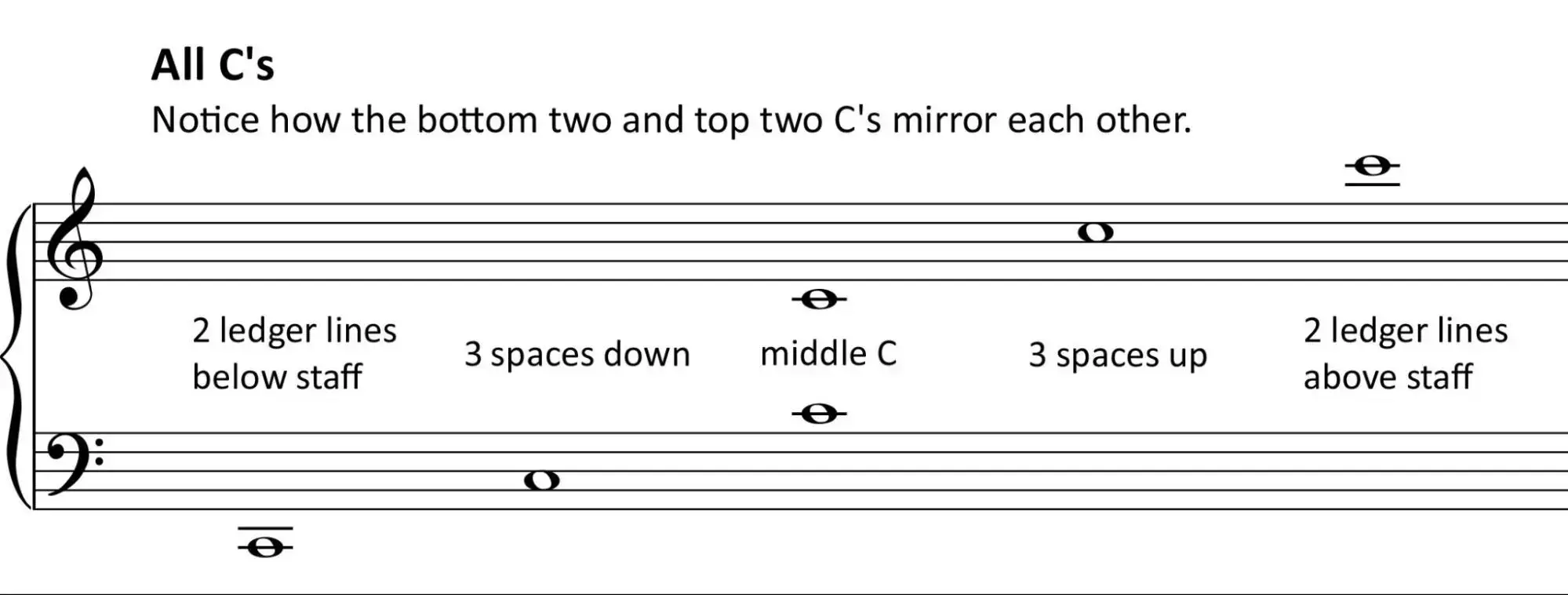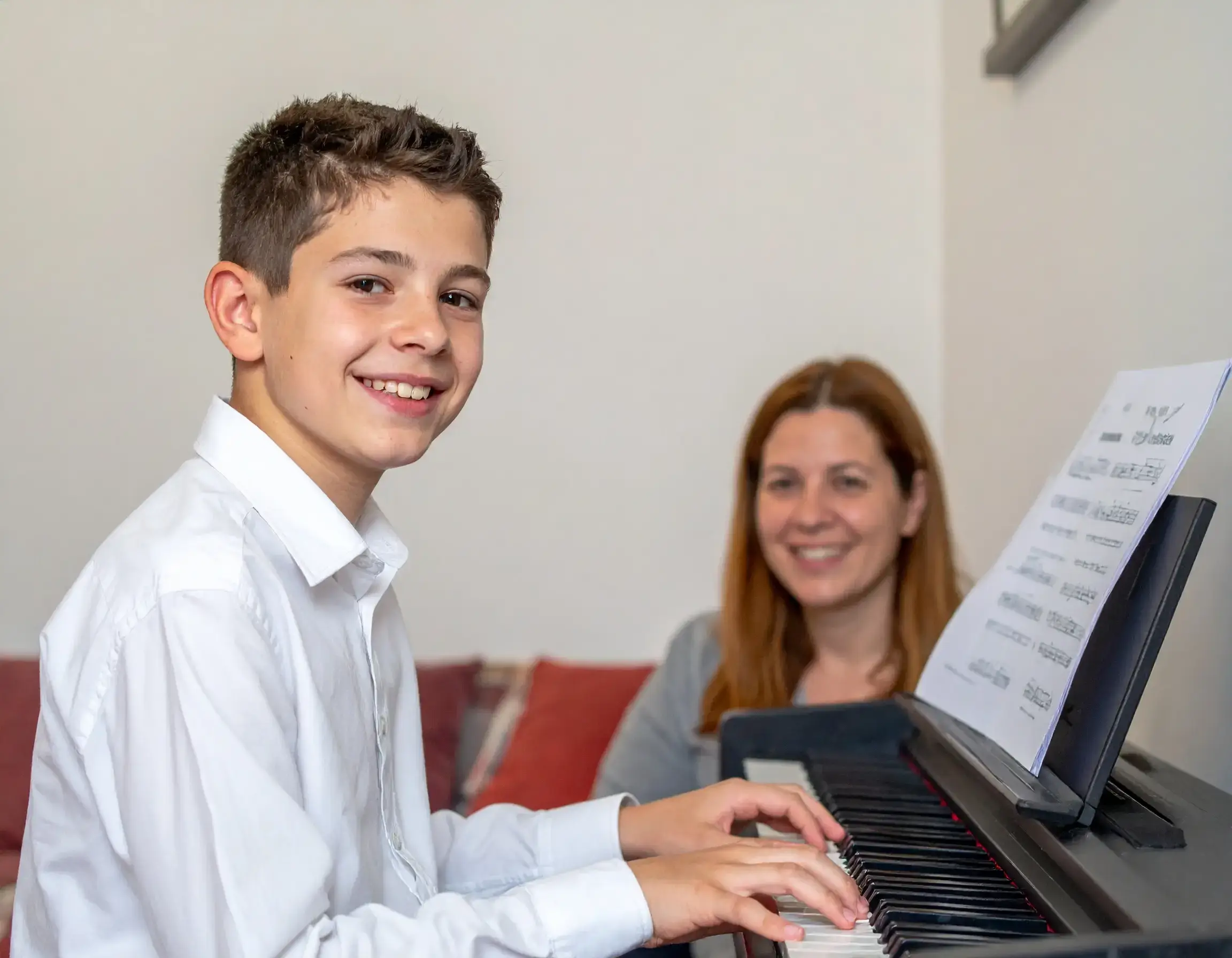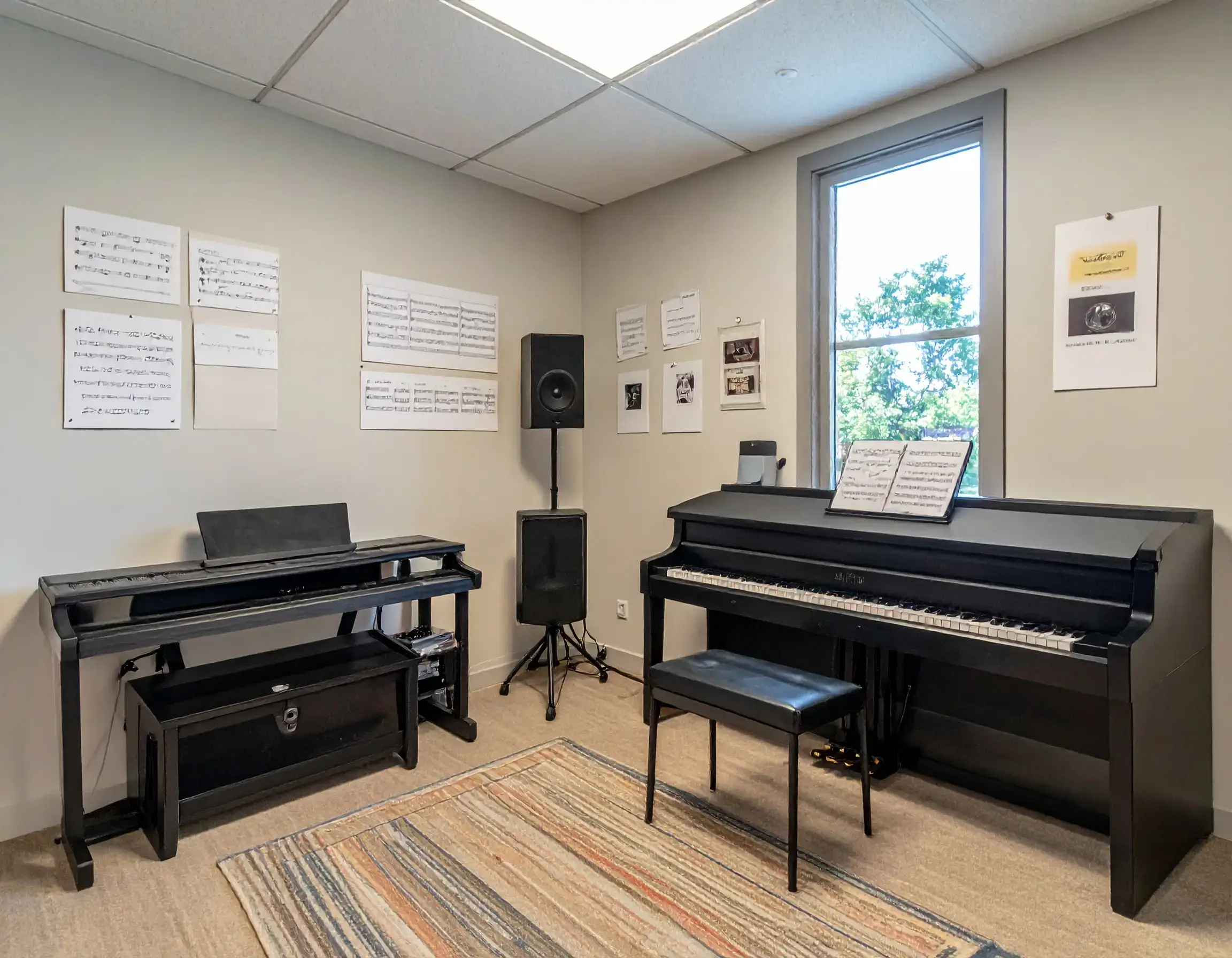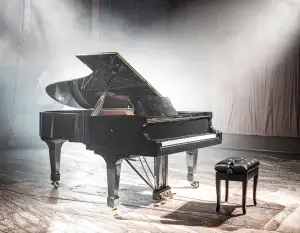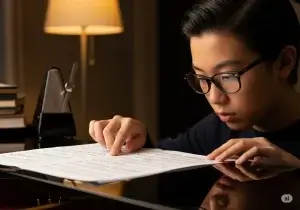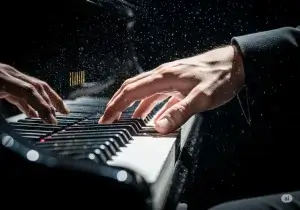All piano beginners must familiarize themselves with the symbols and notation that appear on the page. While reading sheet music can seem intimidating, it is a logical system that will be easy to grasp by following a few simple rules.
At our Mississauga studio, we teach beginner pianists how to read sheet music in easy steps. We start by introducing notes, then the grand staff and simple melodies, gradually building your confidence and skill. Mastering these fundamentals quickly increases your musical ability, sets you up for playing pieces you enjoy, and ensures success in exams such as the Royal Conservatory of Music’s graded piano examinations. Below, we’ll guide you step-by-step through each essential skill.
Why Learn to Read Sheet Music?
Learning to read notation can seem daunting at first, but its benefits are enormous – for amateurs, jazz players, and classical musicians alike. The greatest benefit to reading notation is that it will enable you to learn pieces faster – compared to, say, if you were learning by ear. Reading music notation is like reading a language.
Unlock a World of Repertoire
Once you can read notation, an enormous catalog of music opens up: from beloved childhood tunes to complex classical pieces and film scores. Shared symbols and terminology let you collaborate easily with other musicians.
Play with Greater Accuracy
Sheet music specifies pitches, rhythms, dynamics, and articulations, giving your playing clarity and precision. Reading notation helps you avoid missed notes, refine phrasing, and convey a piece’s emotional character.
Understand a Piece’s Structure
Reading music lets you identify common forms (such as verses, choruses in pop music, or sonata-allegro form in classical music) and see how melody, harmony, and texture combine. This insight allows you to dissect works analytically, understand the composer’s intent, and deepens your knowledge of music theory.
Boost Your Musical Independence
With notation skills, you can learn new pieces on your own, without relying on recordings or someone else’s guidance. You’ll approach unfamiliar repertoire with confidence, maximize every minute of practice, and cultivate self-sufficiency in your musical endeavours.
Introducing the Musical Staff
The musical staff consists of five horizontal lines and four intervening spaces, numbered from bottom to top. Each line and space corresponds to a different pitch. For musicians, the staff serves as our primary guide.
The vertical position of a note on a line or in a space tells you which pitch to play. Each pitch on the piano has its own special space on the staff that never changes. For example, the note on line 1 in the treble clef is the E above middle C. It is only that specific E; it can’t be any other E on the piano. The fixed location of each note on the staff is what makes music notation logically organized.
At the left of each staff, a clef symbol fixes the reference for pitch:
-
Treble clef (G-clef): denotes higher pitches on the upper staff.
Bass clef (F-clef): denotes lower pitches on the lower staff.
Understanding Treble and Bass Clefs
The treble clef curls around the second line of the staff, marking it as G₄ (the G above middle C), and governs all pitches above middle C. The bass clef places its two dots around the fourth line, marking it as F₃ (the F below middle C), and governs pitches below middle C. Each line and space in these clefs carries a specific note name.
To begin memorizing notes, use these two charts:
If you memorize all of the guide notes in these charts, you will be able to use those guide notes to find any surrounding notes.
While many piano teachers suggest using mnemonics (you may have heard “every good boy deserves fudge,” “FACE,” or “all cows eat grass”), they have a huge drawback: you will have to “count up” the staff every time you use a mnemonic. This is time-consuming and slows down your ability to identify notes on sight. Furthermore, you’re not actually learning to read notes this way; you are adding an extra step between looking at the note and identifying it. It is simply not efficient. So I don’t recommend mnemonics to memorize notes.
Memorize the guide notes themselves, and your note reading will become efficient very quickly.
-
The Grand Staff for Piano
The grand staff joins two staves with a brace: the treble staff (top staff) for your right hand, the bass staff (bottom staf) for your left. Together they span the piano’s full range of 88 keys, from A₀ to C₈.
Within each octave, there are twelve semitones – C, C♯/D♭, D, D♯/E♭, E, F, F♯/G♭, G, G♯/A♭, A, A♯/B♭, B – that repeat across the keyboard. Guide notes such as middle C (C₄), bass F (F₃), and treble G (G₄) help you orient yourself on the grand staff.
Reading piano music also means reading rhythm. Note values – whole, half, quarter, eighth (and their corresponding rests) – indicate duration, so you can interpret timing as well as pitch. As you practice, you’ll see how both hands work together in harmony and rhythm, guided every step of the way by the grand staff.
Decoding Musical Notation: Notes, Symbols, and Basics
Learning to read sheet music means studying its visual patterns, shapes, structures and conventions. In this sense, sheet music is a graphical language – full of symbols, notes and lines whose meanings have remained remarkably consistent for centuries.
Our goal is to make these symbols instantly recognizable, so you can approach any piece with informed intuition. Much of Western music relies on repetition – chord progressions, rhythmic motifs and formal patterns. Spotting these right away will speed up both your sight-reading and your performance.
- The Musical Alphabet
Standard notation uses seven letter names, A through G, which repeat across the keyboard. Each piano key corresponds to one of these letters (with sharps and flats in between).
Tip: Drill these with flashcards or apps until you can name any note at a glance. Over time you’ll see that C always sits just to the left of a pair of black keys, D between the black keys, E just to the right of two black keys, and so on. - Lines and Spaces on the Staff
The staff consists of five lines and four spaces. A note’s vertical position on the staff tells you which pitch to play. A line note has the line cutting halfway through the note, like the Earth’s equator. A space note sits between the lines, or touches one line. If you can visually tell the difference between a line note and space note, half the battle of note-reading is won. - Reading by Intervals
This is actually what helps you most in note reading. Intervals are the distance between two notes. Being able to identify this distance between notes on the staff is essential to matching it on the piano keys.
For example, the interval of a 2nd is from a line to the next space, or vice-versa. A 3rd is from a line to the next line, or a space to the next space. Learning intervals and being able to identify them quickly will help you immensely when reading a piece of music, as the notes communicate with each other and follow each other on the staff; they don’t exist in isolation.
- Connecting Notes to Piano Keys
Mapping staff notes onto the keyboard is essential. Regular practice over time will help you get more comfortable with making the association. But there are some things you should not do:
DO NOT color-code the keys or use removable stickers. You will end up relying on the stickers and not associating the notes with the patterns of black and white keys on the piano.
DO NOT write the letter above any note on your sheet music. EVER. You will simply look at the letter and ignore the note. Your note-reading will not improve.
- Note Durations and Rhythm
Each note head and stem combination has an exact time value:
-
- Whole note (semibreve): 4 beats
- Whole note (semibreve): 4 beats
-
- Half note (minim): 2 beats
- Half note (minim): 2 beats
-
- Quarter note (crotchet): 1 beat
- Quarter note (crotchet): 1 beat
-
- Eighth note (quaver): ½ beat
- Eighth note (quaver): ½ beat
- Understanding Time Signatures
A time signature like 4/4 or 3/4 tells you how many beats per measure and which note value gets one beat.
Clap or tap along to music in different meters – common time (4/4), waltz time (3/4), and so on – to feel the underlying grouping. - Sharps, Flats, and Naturals
- Sharp (♯): raises a pitch by one half-step
- Flat (♭): lowers a pitch by one half-step
- Natural (♮): cancels a sharp or flat; always a white key
- Key Signatures as Roadmaps
Key signatures appear at the start of a staff and show which sharps or flats recur throughout the piece.
Use the circle of fifths (a handy flowchart) to learn the order and number of sharps or flats in each key. With practice, you’ll instantly recognize the key and anticipate what notes are altered. - Spotting Common Patterns
Music is inherently patterned – scales, triads, intervals and rhythmic cells recur in countless works.
Highlight and label these patterns in your score if needed to make reading easier.
- The Musical Alphabet
-
Connecting Notes to Your Piano
We start to make the leap from the notes on the page to the keys beneath our fingers. This process creates a connection between visual shapes and our motor coordination. Sheet music is more than dots on a page: every symbol on the staff corresponds to a precise key and pitch on the piano. The staff – the five lines and four spaces – functions like a musical map. Every time we read sheet music, we interpret that map and transform it into sound.
Mapping Notation to the Keyboard
Learning the guide notes (as above) and playing simple pieces at first helps to introduce the relationship between notes on the staff and the keys on the piano.
IMPORTANT: Notes and Rhythm Go Together
When learning a new piece, ALWAYS learn notes and rhythm together. Don’t just learn the notes without any rhythm, and add the rhythm afterward; by doing this, you’re giving yourself extra work, having to undo the bad habit of incorrect rhythm every time you learn a piece.
If you think you can’t learn notes and rhythm at the same time, you are either playing too fast or playing a piece above your level. One of the most important methods for success in learning piano is to SLOW DOWN. Play as slow as you need to in order to get the correct notes and correct rhythm at a steady pace. Once you feel comfortable playing at that slow speed – that is to say, once it feels easy at the slow speed – then you can try it at a slightly faster speed. You will have a much greater chance of playing the piece smoothly and successfully if you have a solid foundation: slow, steady, correct notes and rhythm, and in control.
Playing Your First Simple Tunes
Nothing builds confidence like a small success. We choose beginner-level pieces that use primarily familiar notes and simple rhythms (whole notes, half notes, quarter notes). This reinforces note reading and rhythm while simultaneously enhancing hand coordination.
-
Smart Practice Tips That Work
For beginners learning to read piano sheet music, adopting a few smart habits can accelerate progress and build lasting skills. There’s a direct link between a consistent practice schedule, clear goal-setting, and the effective use of learning tools. Below are eight strategies to make practice an asset rather than a chore.
1. Establish a Consistent Practice Routine
- For an absolute beginner, aim for 15-20 minutes of focused practice each day. Increase to 20-25 minutes after a few weeks.
• Feel free to spend a few minutes (5 minutes or less) on warm-up exercises, such as note identification drills or rhythm clapping exercises.
2. Set Specific, Measurable Goals
- Define one concrete objective per session.
Example: “Today I will be able to name every note on the treble clef staff.”
• Vary your methods – flashcards, mobile apps, and listening games – to reinforce the same target in different ways.3. Go Slow for Accuracy
- Practice new rhythms at a deliberately slow tempo. Do not use a metronome at this point. Feel the steady pulse (like a heartbeat in your mind), and let the notes follow the pulse. (The pulse is always in charge!) If you can’t feel the steady pulse, count out loud as you play.
• When accuracy is established, gradually raise the tempo – this keeps the emphasis on playing the right notes rather than merely rushing.
4. Break Down Tricky Passages
- Isolate challenging measures or small groups of notes
• Once secure, splice the segment back into the larger piece to maintain musical continuity.
5. Use Guide Notes to Memorize Note Names
- The 5 C’s
• The G’s and F’s
6. Practice Sight-Reading Daily
- Find simple sight-reading exercises that are slightly below your current level of skill. If you have just started piano, it may take a few weeks before you can start sight-reading exercises. That’s okay!
• Spend 3-5 minutes per day doing sight-reading exercises
7. Listen While You Read
- Follow along with recordings as you watch the sheet music.
• This links visual notation to aural patterns, reinforcing both pitch and rhythm.
• Create playlists of beginner repertoire – folk songs, simple pop tunes – and sight-read along.
8. Explore Helpful Learning Apps
- Popular choices include Tenuto and Music Theory (both provide note-naming and interval identification exercises)
- For an absolute beginner, aim for 15-20 minutes of focused practice each day. Increase to 20-25 minutes after a few weeks.




